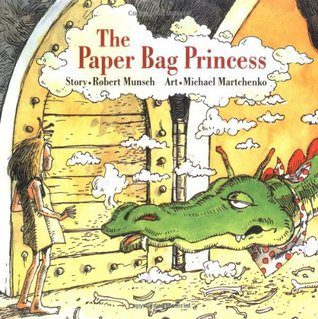Title: The Paper Bag Princess
Author: Robert Munsch
First published May 1, 1980
32 pages, Paperback
ISBN: 9780920236161 (ISBN10: 0920236162)
Rating: 4.31
Overview
Elizabeth was a stunning princess, living comfortably in her castle with her luxurious princess attire. One day, a ferocious dragon appeared and destroyed everything in its path, leaving Elizabeth with nothing but a simple paper bag to cover herself.
With unwavering determination, she sets out to pursue the dragon and reclaim what belongs to her. But, what will happen to the Prince who she was supposed to marry?
Find out in this thrilling tale of bravery and perseverance in The Paper Bag Princess by Robert Munsch.
About the Author
Robert Munsch, the author of many beloved children’s books, was born in Pittsburgh, Pennsylvania. His educational background includes a Bachelor of Arts degree in history from Fordham University and a Master of Arts degree in anthropology from Boston University.
Initially, Munsch had planned to become a Jesuit priest, but his experiences working at orphanages and daycare centers convinced him that he would rather work with children. He obtained a Master of Education in Child Studies from Tufts University in 1973.
Two years later, he moved to Canada to work at the preschool at the University of Guelph in Guelph, Ontario. While teaching in the Department of Family Studies at the University of Guelph, he began publishing the stories he had created for the children he worked with.
In 1979 and 1980, Munsch’s wife experienced the tragic loss of two stillborn babies. From the depths of his grief, he wrote one of his most popular books, Love You Forever.
This book has sold over 6 million copies in paperback alone, and the Munsches have since adopted three children: Julie, Andrew, and Tyya.
Munsch has struggled with obsessive-compulsive disorder and manic depression throughout his life. In 2008, he suffered a stroke that affected his ability to speak in full sentences.
Although he has since recovered enough to perform live, he has put his writing career on hold until he is fully healed.
Editoral Review
Robert Munsch’s “The Paper Bag Princess” is a beloved children’s book that has been entertaining and inspiring young readers since its first publication in 1980. Munsch is a Canadian author who has written over 50 children’s books, and “The Paper Bag Princess” is one of his most popular works.
The book falls under the genre of children’s picture books and is illustrated by Michael Martchenko.
The story follows the adventures of Princess Elizabeth, a strong-willed and independent young girl who is engaged to marry Prince Ronald. However, when a fire-breathing dragon attacks her kingdom and kidnaps Prince Ronald, Princess Elizabeth takes matters into her own hands.
She dons a paper bag, as all her fancy clothes were burned by the dragon, and sets out to rescue her prince. Along the way, she outwits the dragon and saves Prince Ronald, but he is not grateful and instead insults her appearance.
Princess Elizabeth, realizing that she deserves better than to be with someone who doesn’t appreciate her for who she is, walks off into the sunset alone.
The plot of “The Paper Bag Princess” is simple yet impactful, with themes of empowerment, self-worth, and gender roles. Munsch’s writing is engaging and humorous, with a rhythm and rhyme that make the story fun to read aloud.
The illustrations by Martchenko are colorful and expressive, bringing the characters and setting to life.
What makes “The Paper Bag Princess” significant is its subversion of traditional fairy tale tropes. Princess Elizabeth is not a passive damsel in distress, waiting for a hero to save her.
Instead, she takes charge of her own destiny and saves herself and her prince. This message of female empowerment is still relevant today, and the book has been praised for its progressive themes.
However, some critics have pointed out that the book perpetuates negative stereotypes about appearance and reinforces the idea that girls must be pretty to be valued. This criticism is valid, as Princess Elizabeth’s appearance is a central plot point and her lack of fancy clothing is what allows her to outsmart the dragon.
Additionally, the book’s ending, where Princess Elizabeth walks off alone, has been criticized for being too bleak for a children’s book.
Overall, “The Paper Bag Princess” is a charming and thought-provoking children’s book that has stood the test of time. Its strengths lie in its engaging writing, memorable characters, and empowering message.
While it may have some flaws in its portrayal of appearance and gender roles, it is still a valuable addition to any child’s bookshelf. I highly recommend it for young readers, parents, and educators alike.
Rating: 4/5 stars.



